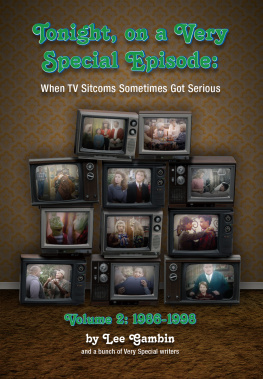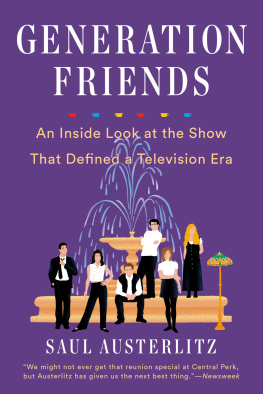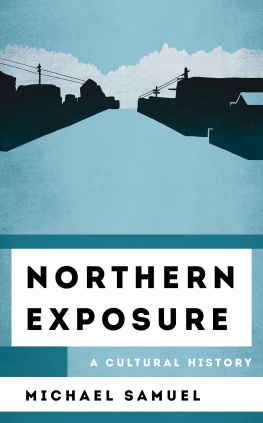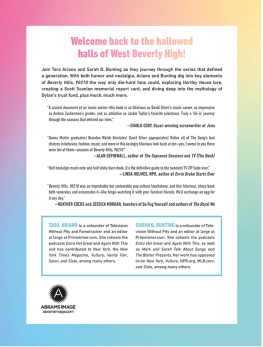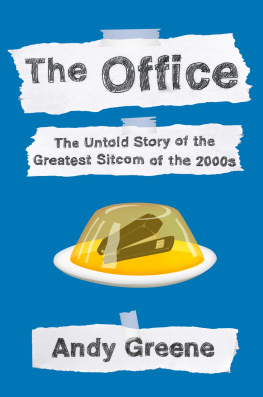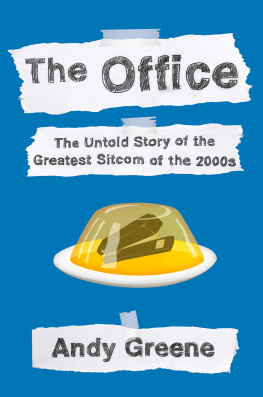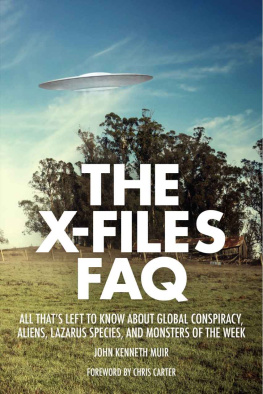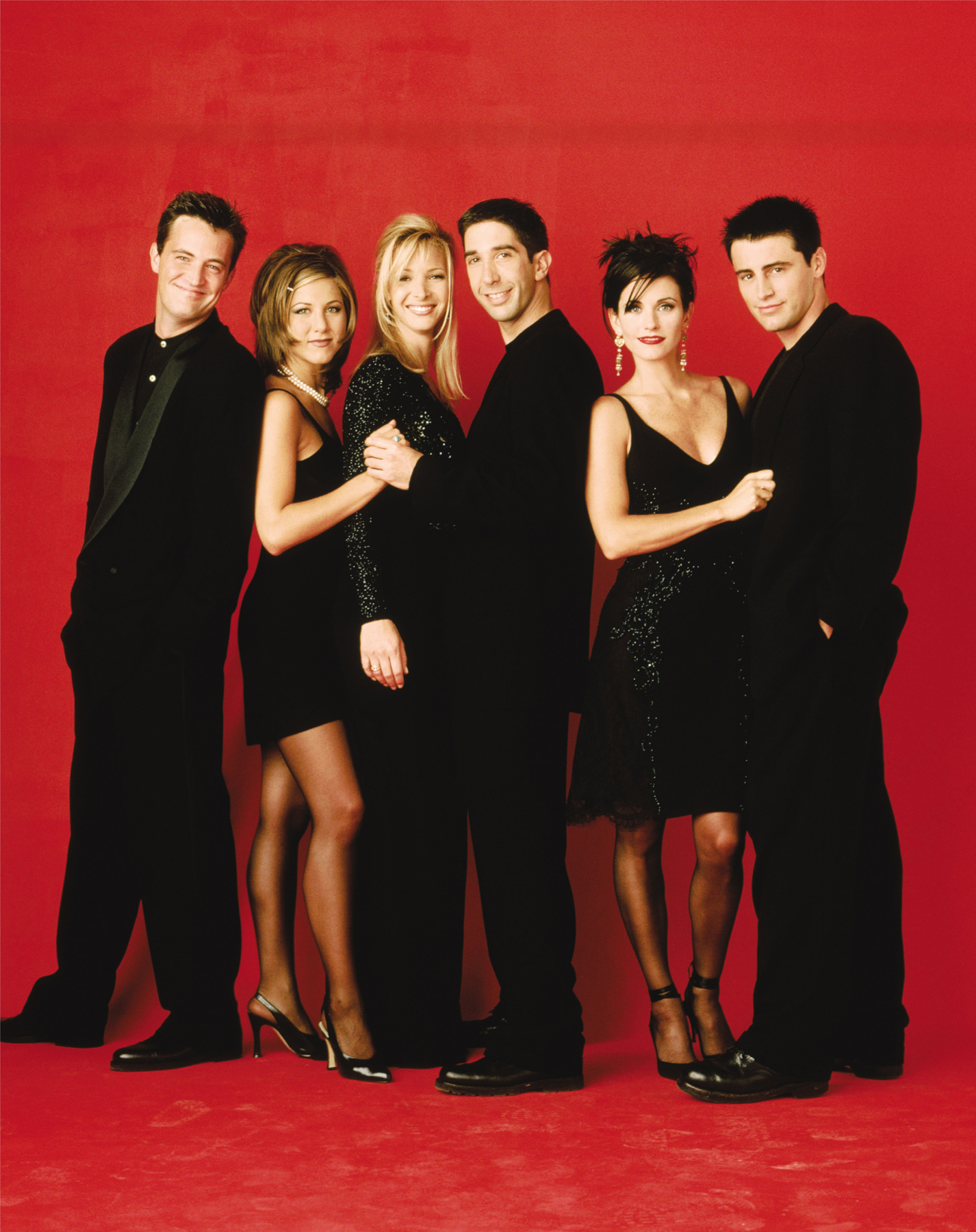
Friends main cast is played by the following actors, shown from left to right: Matthew Perry, Jennifer Aniston, Lisa Kudrow, David Schwimmer, Courteney Cox, and Matthew LeBlanc.
ITS ONLY A TV SHOW.
Thats what Friends co-creators Marta Kauffman and David Crane used to tell each other, laughing about the pop-culture tsunami theyd created, as well as the attempts by scholars to explain its ever-widening impact and what it all meant.
Of course, if Friends really was only a TV show, you wouldnt be reading this book. Really, it was never only a TV show. From the moment it debuted twenty-five years ago, on September 22, 1994, it was an out-of-the-box hit. It turned its little-known cast into paparazzi-hounded superstars, helped NBC create its unbeatable Thursday night Must See TV slate, expanded the range of permissible adult content on prime-time network television, influenced dozens of other shows, and became one of the most beloved series of all time. A quarter-century later, removed from all the history and hoopla, the ten seasons and 236 episodes of Friends still comprise one of the most popular and lucrative series ever createda body of work that continues to endear itself to new generations of fans worldwide, including many fans born after the show went off the air in 2004.
It also got a decade of comic mileage out of a folk song about a stinky pet feline.
Okay, maybe it is only a TV show.
This book is a celebration of that show. In these pages, youll read about how the show came togethereverything from finding the absolutely perfect actors to play each of the six main characters to designing Monicas improbably vast apartment and the cozy coffee oasis that was Central Perk. In the episode guide, youll read all the behind-the-scenes dish about how your favorite Friends moments came to be. And yes, youll read about the shows ever-widening impact.
So find a comfy place to sit and pour yourself a steaming, foamy latte. Weve got a lot to talk about.
HOW THE SHOW WAS CREATED
Whose idea was Friends? Depends on who you ask. Then-NBC-executive Jamie Tarses said the idea for a show about a group of twentysomethings hanging out had already been in the air for a while. Her then-colleague Warren Littlefield claimed hed been thinking of doing a show about young adults in the big city.
Of course, if Friends really was only a TV show, you wouldnt be reading this book.
Dont forget, 1994 was also the year the Generation X wave crested and began to ebb. Remember Generation X? If you dont, thats okay; those of us born between 1965 and 1980 pretty much expected to be forgotten. A demographic footnote sandwiched between the baby boomers and the millennials, Gen X was the ignored middle child, the Jan Brady of generations. Unlike those other groups, Gen X didnt even have a name, just an algebraic placeholder.

Since the first season, the cast of Friends has posed for dozens of creative publicity photos such as this one, known among fans as the milkshake poster.
Gen X did show up on pop cultures radar in 1994for all the wrong reasons. This was the year when Nirvana frontman Kurt Cobain died, when the movie Reality Bites was met with a collective shrug at the box office, and when Elizabeth Wurtzels memoir, Prozac Nation, suggested that her experience with depression and mood stabilizers was characteristic of her entire generation. Whatever window of opportunity Gen X had to make an impact on the culture of its era seemed to be closing. About the only lasting legacy its members had mustered was to make hanging out and drinking coffee in coffeehousespre-Starbucks-on-every-cornera thing.
As for how it all began, Friends is the brainchild of Marta Kauffman and David Crane. The two writer/producers had created the HBO comedy Dream On (199096) together, but theyd had trouble following it up with another hit. The Powers That Be lasted one season (199293) on NBC, and CBS canceled their 1993 series Family Album after just six episodes. The resulting period of uncertainty in their lives reminded them of their own experiences a decade earlier, when they were in their twenties as struggling New Yorkers trying to make it as off-Broadway playwrights. That recollection yielded a premise for another show: six twentysomethings hanging out at a coffeehouse and lending each other moral support as they entered the uncertainty of adult life in the real world. Why six? Because after Dream On, a show that depended heavily upon one lead, Kauffman and Crane wanted to try something new and almost unheard of on TV: an ensemble comedy with six equally important roles.
Crane recollects in a 2019 interview regarding initial conversations about the DNA of their new series and where they wanted to take it: There were some practical elements in that a show we had done previously, Dream On, all took place in a guys head. He was the lead and he was in every scene, which just gets really difficult to do. So we thought, Lets do a show thats a true ensemble, which is hard to do. There arent a lot of true ensembles where youre not following any particular character. In Cheers, obviously youre following multiple characters, but Sam and Diane were your hook. Yes, we had Ross and Rachel, but we didnt know we were going to have Ross and Rachel to that degree. So, we went back to our twenties. Marta and I met in college. We were living in New York for the eighties. We had a group of friends that was not unlike the Friends. Our pitch was, Its that time of your life where your friends are your family. Its now the family you make rather than the family you were given. That was really it. Then we just came up with six characters we really liked. I dont even know today if you could get away with a show thats such a simple concept. The premise is so basic. Its really just the lives of these six people andwhere do we go? That was the gist of it. We went in and pitched that one line and that was pretty much it.
Kauffman and Crane wrote a seven-page treatment for their idea. The passage explaining the premise read, Its about sex, love, relationships, careers, a time in your life when everythings possible. And its about friendship because when youre single and in the city, your friends are your family.
If you put us on Thursday nights, Bright said, you can call us Kevorkian for all I care.


